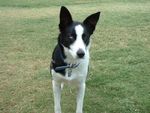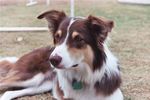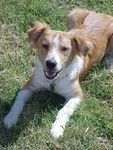The Border Collie: Versatility and Variety
←
→
Page content transcription
If your browser does not render page correctly, please read the page content below
The Border Collie: Versatility and Variety
by G. Chadwick
The Border Collie is widely known for its intelligence, trainability, loyalty and strong
desire to work. People who needed a willing canine partner that could take on complex
tasks driven by their herding instincts have perpetuated these traits in the breed.
Versatility. In 1994 in his book titled, “The Intelligence of Dogs” author Stanley Coren
named the Border Collie as the most intelligent breed. This was in no way a surprise to
Border Collie fans, particularly since intelligence was defined by the author as “working”
intelligence (a combination of bidability, or willingness/desire to learn, and speed of
learning tasks requiring fewer reinforced repetitions to master behaviors). Other breeds
may have more ability for scenting tasks, more instinct to retrieve, stronger affinity for
swimming, more natural show ring bravado. The Border Collies’ versatility beyond most
other breeds is enriched by its physical athleticism and an active canine mind that
demonstrates learning and thinking is fun for this breed.
Border Collies and other high-drive herding breeds,
dominate the ranks of the working stock dog. In addition,
Border Collies can be found at the top levels of nearly every
dog sport (agility, flyball, flying disc, luring, tracking, musical
canine freestyle, big air, etc.) More recently, Border Collies
have been worked with great success at keeping golf
courses and airport runways free from geese, ducks and
other migrating fowl. A Border Collie can quickly master
most things that a dog can be taught to do.
By now, the reader may be thinking that Border Collies just
may be the perfect dog. Many Border Collie lovers would
agree. There is just one job at which your average Border
Collie may consistently fail and that is the role of “couch
potato” or “backyard dog”. Border Collies are high energy, active dogs and they need a
job to do. If you don’t provide mental and physical activity that your dog needs, the dog
may invent it’s own “games” (which can include habitual behavior like barking, digging
and chewing).
This may explain why, during the process of rehoming rescued
Border Collies, there is a particular interest in what the
adoption applicant plans to DO with the dog. The occasional
trip to the dog park or monthly weekend hike is not an
adequate routine for most Border Collies.
The special relationship that is observed between a highly
trained dog and its human companion is awesome to see.
Unfortunately, many families that chose a Border Collie for the
first time end up disappointed because they are not set up to
expend the time this breed requires. If you are willing and
able to spend the time training, exercising, and building a
strong bond with your new dog, that special relationship
becomes very possible. Natasha – 2003 ABCRescueVariety.
Appearance. For most of the history of the breed, the physical appearance of Border
Collies was of secondary concern, perhaps more determined by climate and personal
preference or random factors. The priority was always on the dog’s working ability.
For a number of years (and continuing to the present) the recognition of the Border
Collie breed by the American Kennel Club and the UKC had been strongly opposed by
advocates of the breed who believe that a focus on breeding for specific appearance
standards will generally weaken the working ability of the breed. Despite objections, in
1995 the AKC recognized standards for the Border Collie breed in the Herding Group.
Standards. As a result of AKC and UKC registration, there now exists a standard of
appearance in these breed-focused registries. Other stock dog registries (such as the
North American Sheepdog Society - NASDS and the American Border Collie Association
- ABCA) also continue to register litters from proven working dogs but are opposed to
any type of conformation standard. So a “registered” Border Collie could mean a dog
that comes from a number of different registries that are focused on very different
standards. Given the diversity in appearance that has existed in the breed, all the
variations in eye color, ear shape, size, color and coat type continue to be recognized as
part of the Border Collie breed.
The American-International Border Collie Registry, Inc (AIBC) states that male Border
Collies can be between the sizes of 18” to 24” in height at the shoulder and females 17”
to 22”. It is not uncommon for males and females to be of the same size in this breed.
Weight is from 30 and 60 pounds. The AKC supports a more narrow standard (Males
19” – 22” and 18” – 21” for females).
Eye Color. Variations are recognized in Border Collie eye color, which can be shades of
brown from dark brown to light gold, or blue eyes.
(At left) Variations in eye color: soft dark brown
Shayla, blue-eyed Tessa, and light brown Kylie (2003
ABCRescue). The red-coated BCs often have
lighter brown eyes.
(At right),
Bi-eyed
Zephyr (2003
ABCRescue)
Border Collies can also have a greenish cast to their
eyes, flecking (although that eye colorations is more
common in Australian Shepherds) and eyes of two
different colors (called bi-eyed).
Coat. Perhaps the area of most obvious variety is in coat, first in color and color pattern
and second in coat length. Coat texture can vary from hard/coarse to soft/silky.Medium and long coats can also be straight, curly or wavy. The ideal coat (short or
long) is double, with a dense undercoat and a somewhat coarse, outer coat.
Color: The “traditional” Border Collie is a medium sized dog (35-45 lbs), with a rough
(medium long) black coat color with white markings arranged in the typical “collie”
pattern (white blaze on face and white muzzle, white ruff encircling the neck, white
chest, four white feet and a white tip on the end of the tail).
(At left) Buddy, Classic Black/White
(2003 ABCRescue)
A fairly common variation to the
traditional look is the “split face”
(black over one eye and white
over the other).
(At right) Ralph (2004 ABCRescue)
The second most frequent color of Border Collies would be the “reds”. This color can be
seen with traditional white markings or variations in the white pattern with the reddish
brown ranging from a dark mahogany brown to a pale rust shade.
Range of Reds – Mahogany, Red/White, Rust/Tri-Color
Ruby (2002 ABCR), Scout, Kylie (2003 ABCR)
(At left)
Scout (ABCR Member’s Classic Red/White Color)
Other variations to the classic “collie” patterning also
occur regularly. These dogs, called “patterned whites” come in many variations, from
large areas of black, red or merle to mostly white on the body.
Patterned Whites
Mae (2003 ABCRescue) Blake (2003 ABCRescue) SeekerA less common basic color would be blonde/light tan with
traditional white pattern. In some countries this strawberry
blonde color is called “red” and the darker reddish-brown is
called “brown”.
(At left)
Blonde Border Collie Pup
Brody (2004 ABCRescue)
(At right)
Blue Merle (tri-color) Border
Collie - Kody (2004
ABCRescue)
Although seldom seen in rescued dogs, Border Collie coats have been produced in blue
or red merle color, or a lilac cast (muted blue/gray), lemon/white (light gold) and even
brindle coloring.
Any of the colorations can
also have small spotting
(often called “ticking”) on the
white areas (legs, face and
chest). The ticking can vary
from a few spots to very
dense. Some refer to
profusion of lots of small size
ticking as a coat color called
“sooty”.
(At left) – Turk (2003 ABCR)
(At right) – Pirate (2003 ABCR)
All of the coat colors can also be seen with tri-coloring. The
tri-colors are dogs with a pattern of tan/rust points on their
face (below each eye), “eyebrows”, and legs (where the
white meets the darker coat color).
Red Tri – Color
Kylie (2003
ABCRescue)
Black Tri – Color
Max (2003
ABCRescue)Coat Type (Length): When people become interested in Border Collies they often
comment that they didn’t realize BCs could have short coats. In reality coat length
varies from very short (called smooth coats), through medium, to a long, thick double
coat (called rough coats). Usually the rough coated dogs have longer fur (feathering) on
the backs of
their legs and
tail plume and a
longer ruff
(around their
neck), with
shorter fur on
the face and
front of legs and
feet. Examples
of the variety of
coat length are
pictured here.
Short Coat – Jack (2003 ABCRescue) Rough/Long Coat - Ladd (2004 ABCRescue)
Black/White Medium Coats Black/White Medium Curly Coat
Natasha & Boris (2004 ABCRescues) Axle (2004 ABCRescue)
Ear Carriage: The last area of variation in Border Collies would be in the ears. Ears are
usually seen in tipped (also called semi-erect or tulip ears), drop ears, prick, or sideways
folding. It is also common in Border Collies for the individual dog to have ears that are
different (one pricked and one bent), often referred to as mixed ears.
Left to right: ABCRescues with Sideways (“Yoda”) ears, Mixed ears, and Drop ears.Left to right: ABCRescues Skye with prick ears and Kylie with tipped (aka semi-erect or tulip ears)
Gait and Movement. With all this variety, in Border
Collie Rescue (usually without benefit of pedigrees or
knowledge of working skills of the breeding lines), we
are often challenged to determine which dogs are
Border Collies. Often the most telling factor is the
general demeanor of the dog, including its energy
level, the intelligent, inquisitive look in the eye, and the
dog’s gait or movement.
(At right) Hawk
(2002 ABCRescue)
exudes energy
(Below) Working boy, Gus, in classic BC crouch
The Border Collie is an agile dog, able to
suddenly change speed and direction without
loss of balance and grace. When intent upon
an object of interest (a toy, a treat, or stock)
there is often a crouch or stalk position with a
steady gaze (the Border Collie “eye”) and a
lowered head. The movement is free, smooth
and tireless, with a minimum lift of the feet
and an overall balanced appearance.
Typically the body is slightly longer than it is tall, and is capable of speed and quick
reactions. Even the more appearance-focused breed registries (i.e., AKC) state that in
Border Collies color and markings are always secondary to physical evaluation and gait.
When and if you decide to adopt a rescued Border Collie, understand that every dog is a
unique individual with his own personality. Intelligence, trainability and instinct vary with
each dog. The rewards of living with a Border Collie are many, once you understand the
commitment.
(This article may be reprinted in whole or in part for the purposes of promoting Border Collie
rescue, with permission from Arizona Border Collie Rescue.)You can also read



























































